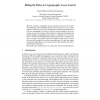Free Online Productivity Tools
i2Speak
i2Symbol
i2OCR
iTex2Img
iWeb2Print
iWeb2Shot
i2Type
iPdf2Split
iPdf2Merge
i2Bopomofo
i2Arabic
i2Style
i2Image
i2PDF
iLatex2Rtf
Sci2ools
IACR
2011
2011
Hiding the Policy in Cryptographic Access Control
Abstract. Recently, cryptographic access control has received a lot of attention, mainly due to the availability of efficient Attribute-Based Encryption (ABE) schemes. ABE allows to get rid of a trusted reference monitor by enforcing access rules in a cryptographic way. However, ABE has a privacy problem: The access policies are sent in clear along with the ciphertexts. Further generalizing the idea of policy-hiding in cryptographic access control, we introduce policy anonymity where – similar to the well-understood concept of k-anonymity – the attacker can only see a large set of possible policies that might have been used to encrypt, but is not able to identify the one that was actually used. We show that using a concept from graph theory we can extend a known ABE construction to achieve the desired privacy property.
Abe | Graph Theory | IACR 2011 | Privacy Problem |
| Added | 23 Dec 2011 |
| Updated | 23 Dec 2011 |
| Type | Journal |
| Year | 2011 |
| Where | IACR |
| Authors | Sascha Müller, Stefan Katzenbeisser |
Comments (0)

